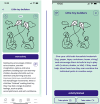Promoting social, emotional, and cognitive development in early childhood: A protocol for early valuation of a culturally adapted digital tool for supporting optimal childrearing practices
- PMID: 38596404
- PMCID: PMC11003334
- DOI: 10.1177/20552076241242559
Promoting social, emotional, and cognitive development in early childhood: A protocol for early valuation of a culturally adapted digital tool for supporting optimal childrearing practices
Abstract
Objective: The Thrive by Five app promotes positive interactions between children and parents, extended family, and trusted community members that support optimal socio-emotional and cognitive development in the early years. This article aims to describe the protocol for a prospective mixed-methods multi-site study evaluating Thrive by Five using surveys, interviews, workshops, audio diaries from citizen ethnographers and app usage data.
Methods: The study activities and timelines differ by site, with an extensive longitudinal evaluation being conducted at two sites and a basic evaluation being conducted at five sites. The learnings from the more comprehensive evaluations inform the iterative research and development processes while also ensuring ongoing evaluation of usability, acceptability and effectiveness of the app and its content across varying contexts. The study evaluates: (1) the impact of the Thrive by Five content on caregiver knowledge, behaviours, attitudes and confidence; (2) how the content changes relationships at the familial, community and system level; (3) how cultural and contextual factors influence content engagement and effectiveness and (4) the processes that facilitate or disrupt the success of the implementation and dissemination.
Results: All in-country partners have been identified and data collection has been completed in Indonesia, Malaysia, Afghanistan, Kyrgyzstan, Uzbekistan, Namibia and Cameroon.
Conclusions: Very few digital health solutions have been trialled for usability and effectiveness in diverse cultural contexts. By combining quantitative, qualitative, process and ethnographic methodologies, this innovative study informs the iterative and ongoing optimisation of the cultural and contextual sensitivity of the Thrive by Five content and the processes supporting implementation and dissemination.
Keywords: digital technology; early child development; evaluation; global health; mobile app; participatory research; qualitative research; smartphone.
© The Author(s) 2024.
Conflict of interest statement
The authors declared the following potential conflicts of interest with respect to the research, authorship, and/or publication of this article: IBH is supported by a NHMRC L3 Investigator Grant (GNT2016346). He is the co-director, Health and Policy at the Brain and Mind Centre (BMC) University of Sydney. The BMC operates an early-intervention youth service at Camperdown under contract to headspace. He is the chief scientific advisor to, and a 3.2% equity shareholder in, InnoWell Pty Ltd which aims to lead transformation of mental health services internationally through the use of innovative technologies. VL is a board member for Matana Foundation, a philanthropic organisation that provides funding to programmes for disadvantaged young people in Australia. She does not receive any financial benefit for this role. No other authors have competing interests.
Similar articles
-
Enhancing equitable engagement for digital health promotion: Lessons from evaluating a childrearing app in Indonesia.Digit Health. 2023 Dec 25;9:20552076231222112. doi: 10.1177/20552076231222112. eCollection 2023 Jan-Dec. Digit Health. 2023. PMID: 38152442 Free PMC article.
-
Parenting app to support socio-emotional and cognitive development in early childhood: iterative codesign learnings from nine low-income and middle-income countries.BMJ Open. 2023 May 16;13(5):e071232. doi: 10.1136/bmjopen-2022-071232. BMJ Open. 2023. PMID: 37192801 Free PMC article.
-
Developing Culturally Appropriate Content for a Child-Rearing App to Support Young Children's Socioemotional and Cognitive Development in Afghanistan: Co-Design Study.JMIR Form Res. 2023 Aug 23;7:e44267. doi: 10.2196/44267. JMIR Form Res. 2023. PMID: 37610805 Free PMC article.
-
Developing a Parenting App to Support Young Children's Socioemotional and Cognitive Development in Culturally Diverse Low- and Middle-Income Countries: Protocol for a Co-design Study.JMIR Res Protoc. 2022 Oct 31;11(10):e39225. doi: 10.2196/39225. JMIR Res Protoc. 2022. PMID: 36315237 Free PMC article.
-
Designing an App for Parents and Caregivers to Promote Cognitive and Socioemotional Development and Well-being Among Children Aged 0 to 5 Years in Diverse Cultural Settings: Scientific Framework.JMIR Pediatr Parent. 2023 Feb 13;6:e38921. doi: 10.2196/38921. JMIR Pediatr Parent. 2023. PMID: 36780220 Free PMC article.
Cited by
-
Psychometric evaluation of the System Usability Scale in the context of a childrearing app co-designed for low- and middle-income countries.Digit Health. 2025 May 11;11:20552076251335413. doi: 10.1177/20552076251335413. eCollection 2025 Jan-Dec. Digit Health. 2025. PMID: 40357428 Free PMC article.
-
Top 10 Research Lessons Learned From a Digital Child-Rearing Program in Low- and Middle-Income Countries: Multicase Study.J Med Internet Res. 2025 Jul 29;27:e65705. doi: 10.2196/65705. J Med Internet Res. 2025. PMID: 40729687 Free PMC article.
-
Applications for the management of Attention Deficit Hyperactivity Disorder: a systematic review.Front Public Health. 2025 Feb 27;13:1483923. doi: 10.3389/fpubh.2025.1483923. eCollection 2025. Front Public Health. 2025. PMID: 40084214 Free PMC article.
-
Enhancing equitable engagement for digital health promotion: Lessons from evaluating a childrearing app in Indonesia.Digit Health. 2023 Dec 25;9:20552076231222112. doi: 10.1177/20552076231222112. eCollection 2023 Jan-Dec. Digit Health. 2023. PMID: 38152442 Free PMC article.
-
Parental emotional adjustment as a primary target for parenting programs: a cross-sectional study.BMC Psychol. 2025 Jun 4;13(1):601. doi: 10.1186/s40359-025-02646-8. BMC Psychol. 2025. PMID: 40468380 Free PMC article.
References
-
- Johnson MH. Functional brain development in humans. Nat Rev Neurosci 2001; 2: 475–483. - PubMed
-
- Holtmaat A, Svoboda K. Experience dependent structural synaptic plasticity in the mammalian brain. Nat Rev Neurosci 2009; 10: 647–658. - PubMed
-
- Walker SP, Wachs TD, Grantham-McGregor S, et al. Inequality in early childhood: risk and protective factors for early child development. Lancet 2011; 378: 1325–1338. - PubMed
-
- Walker SP, Wachs TD, Gardner JM, et al. Child development: risk factors for adverse outcomes in developing countries. Lancet 2007; 369: 147–157. - PubMed
LinkOut - more resources
Full Text Sources


